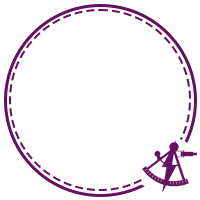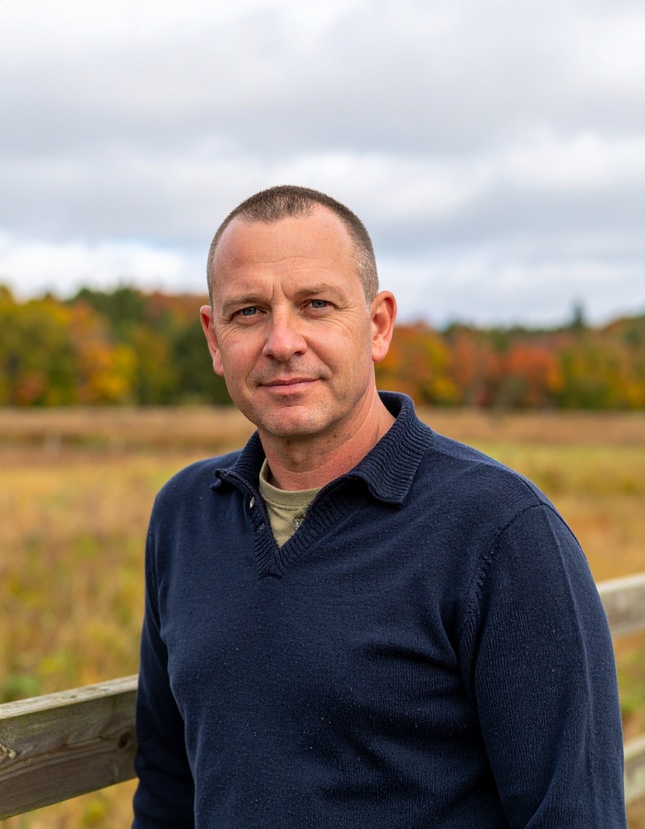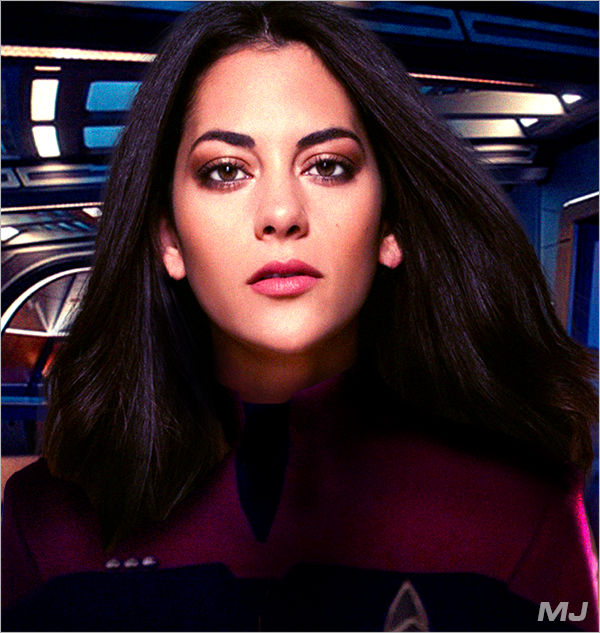Attached to the manipulator arms of a Sphinx-type workpod, a large probe exited Arondight’s depressurized Shuttlebay 1. Part navigational beacon, part signal relay, and part multi-spatial sensor, O29 was the link in a chain that had taken the starship’s new crew three weeks to set up in the Olympia system. Arranged in two rings that originated at Olympia Station on one end and met at O8 halfway across the system, these new probes were a light second from one another. They would provide unmatched sensor data for the station to defeat the pesky problem of the planet Olympia III, occluding the station’s view of the space behind it. Their line-of-sight communications system was one thing the Starfleet Corps of Engineers had managed to salvage from the debacle that was the Fleet Formation Mode system—even in times of significant subspace interference, communication between the probes could be maintained through a direct laser connection that meant there would be no more than an eight-second lag from one end of the system using a tight-beam RF connection that could only be blocked by physically intercepting it. Starships would also be able to receive navigational data from any angle of approach into the system, and the probes would provide detailed climate data on Olympia III to predict every single drop of rain that might fall on the Clio colony.
From his post at the science station on the bridge of the Arondight, Lieutenant Commander Tristan Hawthorne found the whole concept to be a little overkill. A single satellite orbiting the far side of the planet opposite from Olympia Station’s synchronous position over the colony would have sufficed. However, it had provided him with much hands-on practice with calibrating sensor pallets. As a linguistic anthropologist by training, he’d needed it.
“Commander Costa has released Oscar-Two-Nine and is returning to the bay. Deployment successful, Captain,” Lieutenant Robinson reported from the operations station facing the starboard bulkhead to the captain’s right. Cooper Robinson, along with Paulo Costa and Shadi Oxel, was another middle-decker from Arcturus thrust into a senior officer role aboard Arondight thanks to significant staffing gaps. “Oscar-Two-Nine has engaged its automatic attitude and position stabilization systems and has achieved positive lock on its connections to Oscar-Two-Eight and Olympia Station.”
The display over the science station matched Robinson’s analysis as the last node in the grid switched from grey to green. Hawthorne was quietly pleased that Costa would be safely back aboard the Arondight to boot. EVA, even in a Sphinx, had always made him nervous.
“Confirming good telemetry from twenty-nine,” the science officer reported, in quiet protest to the silly protocol of using the phonetic alphabet—there was only one letter, after all. “We’re ready to begin synching and calibrating the grid to the station’s primary sensor arrays. We’ll need to establish an additional secure link to Olympia’s main computer to audit.”
“Very well,” Captain Blake Bennett replied cooly from the center seat.
Hawthorne had yet to get an accurate read on the inscrutable Scotsman, who managed to be both charming and aloof simultaneously. He managed to bring personal warmth together with professional distance. While he seemed to know every crew member’s full name, planet of origin, and the highlights of their service dossier, he only ate alone or with a handful of senior officers. He was an enigma—not that Hawthorne had that much experience dealing with captains directly, anyway.
“Excellent work, everyone,” the captain added. “Mister Hawthorne, you have the bridge until the first officer returns. Begin your preparations and inform me when we’re ready to move into position for final calibration,” he ordered.
The science officer wheeled around in his chair just as the captain stood up, which pulled him on a string made of protocol to a standing position. The bridge was compact because of the Reliant class frigate’s truncated deck one. However, it still managed to cram ten bulkhead stations around the sides of the elevated command platform with the helm and tactical stations forward. Hawthorne’s station was directly aft of the captain’s chair, and he liked facing away from the viewer, as it let him focus on his work. Before transferring to Arondight, Hawthorne had been on a starship’s bridge at most two or three times in his life and only once while on Arcturus. That moment was the first time he’d been ordered to take command, other than on the holodeck.
“Aye, Captain,” Hawthorne replied, though he felt a bit of his anxiety slipping out as he scrambled up the two short steps and around the railing that separated the science and communications stations from the captain’s seat.
“You’ll be fine, Hawthorne,” Bennett said with a slight smirk as he clapped the science officer on the shoulder and proceeded aft to the ready room.
After eyeing the captain’s chair momentarily as if it were a creature liable to attack him, Hawthorne reluctantly settled into it. He crossed one leg over the other at the knee and let his hands settle on the armrests for a moment as he took a deep breath. He then rolled his eyes at his own emotional state—the ship was stationary and just under 300,000 kilometers from spacedock. It was the least probable place in the universe to run into trouble.
“Mr. Robinson, please link our computer with the station’s over a secure subspace channel,” Hawthorne ordered.
“Aye, Captain,” Robinson said, a teasing lilt coming into his voice. It would be a stretch to say that Robinson and Hawthorne were exes, as they’d never made it past the first few dates. Still, Hawthorne knew Robinson well enough to expect a little bit of teasing—the Canadian lieutenant’s first language was English, his second was French, and his third was sarcasm. “With the new security protocols, it will take twenty minutes to complete the necessary authentication protocols. If you want to get the full acting captain package, there’s time for a spin around the block, sir.”
Robinson spun around from the operations console to grin at Hawthorne, his bright, white teeth looking simultaneously unsettlingly perfect and coprophagous. Lieutenant Lassus at the helm and Lieutenant Sadir filling next to her at tactical turned around with looks of bemusement on their faces.
“No joyrides,” Hawthorne said curtly to the palpable disappointment of the crew.
They went about their duties for several minutes while Hawthorne reviewed the initial data coming in from the network on a holographic display projected in front of the captain’s chair. Like all Starfleet science officers, he had broad technical training. Switching to astrophysics was like riding a bike—though he still felt a little shaky. Something was troubling about the data coming in from their newest probe, though. He was seeing a spike in tachyon particles. Tachyons were most often associated with various natural phenomena, but they could also be produced by wormholes, cloaking devices, and even transporters.
“Ops, please confirm a good connection to our last deployment,” Hawthorne ordered.
“Checking,” Robinson replied. “Computer confirms good. Level five diagnostic shows no issues with the transceiver array on our end or with the probe. Is something wrong?”
Hawthorne dismissed the holographic display with a wave of his hand and left the center seat to stand behind Robinson. While irredeemably silly, the operations officer’s technical acumen was stronger than Hawthorne’s. After leaning in with a hand on the back of Robinson’s chair to get a good look at the diagnostic readings, he tapped one of the upper displays to show him what he’d seen.
“There’s a small surge in tachyon particles, but it’s only coming from Oh-twenty-nine,” Hawthorne explained.
“I see it,” Robison agreed. “That’s unusual, but these readings are barely higher than the baseline. It could be a ghost in the calibration process,” he suggested. “Should we alert the captain?”
Hawthorne considered that response and began to question his understanding. It could be a problem with the computer’s analysis—a blip that would be ironed out when the system was fully online.
“No, not yet. It’s odd, but it’s not dangerous,” the science officer demurred. A moment later, the readings leveled out to normal. “How unusual.”
“What’s unusual?” Lieutenant Commander Paulo Costa asked as he entered the bridge, fresh from his mission to deploy the probe.
“Sir,” Hawthorne said with a polite nod, though he found himself swallowing involuntarily in Costa’s presence. They had been co-workers long before they had been lovers, but he still found himself acting like a schoolboy in the other man’s presence. Costa had been catapulted further than most: from the deputy helmsman aboard Arcturus to the first officer on Arondight. “There was a very minor tachyon anomaly being registered by this last probe, but it’s gone now. We’ve already run a diagnostic.”
Costa nodded, and Hawthorne felt his chocolate-colored eyes scanning him quite blatantly. He also saw Robinson begin to smirk, so he cleared his throat.
“Keep an eye on it. What’s our general status?”
“We’ll be synced up with the station’s computer in seventeen minutes. The captain has asked that we inform him when we are ready to move to our calibration position in the outer solar system, Commander,” Hawthorne said, stepping away from Robinson’s station and gesturing towards the command seat. “You have the bridge, sir.”
“I have the bridge,” Costa confirmed with a nod. “Thanks for keeping the chair warm for me.”
“Commander,” the science officer managed as an acknowledgment before returning to his station.
The calibration process was tedious, but compared to installing the probes, it was at least quick. They’d been crawling along at one-tenth impulse to perform the initial calibrations and ensure the probes’ abilities to maintain target lock. Then, each probe took six hours to be brought into a flight-ready status and deployed, which could only be done in a zero-gee environment with null gravity. Hence, the shuttlebay had to be depressurized, and the crew had to work in EV suits. During the final calibration of the whole system, they were able to zip around at a quarter impulse, providing various sample readings to test the accuracy of the network. It took all of alpha shift, but by the time the swing shift crew emerged from the turbolifts at the back of the bridge, the Olympia Multispatial Navigational Buoy Network was declared fully operational.
“Oh-em-en-bee-en,” Lieutenant Robinson sounded out as he walked off the bridge with Lieutenant Sadir. “Omni… Bean? Bacon? Oh, Beacon? The Omni-Beacon,” he said, causing the security officer to laugh.
“It rolls off the tongue,” Sadir quipped. “Coming, Mr. Hawthorne?”
Hawthorne was pretending to be making some last-minute inputs into his science station while he waited for Costa to finish briefing Lieutenant Solomon for his stint as acting captain so that he could get him alone. They’d been following up their long, tedious duty shifts with trips to the ship’s gym or pool. Or just directly to one of their beds.
“Ah, I see. We’ll see you later, sir,” Sadir replied once Hawthorne’s thoughts drifted to the first officer.
Blush crept onto the edges of Hawthorne’s high cheekbones as he felt a tinge of embarrassment wash over him as the doors to the turbolift closed. He was certainly not ashamed of Costa, but they were going out of their way not to call attention to their relationship—a relationship that was exciting, passionate, and healthy but which was also still ill-defined. There were several reasons that Hawthorne found Sadir intimidating: on top of being a telepath, he was also a man who was fully two meters tall, made of lean muscle that seemed to always be on display off duty in one half-open Betazoid garment or another. It was a lot to try to feel impressive around. He shook those feelings off when Costa walked over to him.
“You look like you’re thinking a lot of thoughts,” Costa noted.
“I am. Let’s go..,” Hawthorne replied, starting to walk away from his station. As he did so, though, he noticed something unusual on their lateral sensors. It was a tachyon spike, but it had only been there for a split second. He hesitated. “That’s odd.”
“Another sensor not playing nice?”
“I thought so, but I think I’m losing it,” the science officer murmured. He tapped his combadge and cleared his throat. “Hawthorne to Engineering. Please run a level three diagnostic on the starboard lateral sensors. It’s probably nothing, but I think I saw an errant reading.”
“Understood, Commander. We’ll get it done this shift,” the person on the other end of the line reported.
“Shall we?” Hawthorne asked. “I’d love to do anything but stare at graphs for a while.”
“I have a few thoughts on what we could do to occupy our time,” Costa replied as they walked to the port turbolift car. Hawthorne’s heart rate accelerated as he imagined what items may be included. “Tennis or swimming?” he asked once the turbolift door closed.
“Is a nap not on the list?” Hawthorne complained. He closed his arms and rapped his fingers insistently on his bicep as he considered those two options. Swimming would involve seeing Costa basically naked, which was always a plus, but tennis was something Hawthorne could beat him at—and that was even more satisfying. “Fine, tennis.”
“Computer, deck four,” Costa ordered. He sidled over to Hawthorne and put his arm around him. “For the record, a nap is item number three on the to-do list.”
“What’s the second item?”
“You are,” Costa said, whispering right into Hawthorne’s ear. “You’re also number four.”
Hawthorne swallowed in a feeble attempt to stop from shuddering at the feeling of Costa’s hot breath on his skin and the low timbre of his voice. Nothing was ever straightforward with Paulo Costa—even at his most anodyne and puppy-like moments, he just had to push Hawthorne’s buttons—though Hawthorne had come to enjoy their repartee immensely. That day, though, he wanted desperately to just kiss him and skip a few items on that list, needing to transmute the stress and anxiety of an important day into passion and relief, but the ride from the bridge to deck four took less than ten seconds, thanks to the magic of the turbolift system’s inertial dampeners.
“Acceptable,” he managed as the doors opened to the corridor.
As the two men made their way to the fastest tennis match in recorded history, the science station on the bridge was vacant. Indicators for multiple probes in the new sensor network began to pulse slowly. Nothing they were picking up had yet hit the threshold for review by a sentient operator either on Olympia or on Arondight. Still, a tiny torrent of tachyons was beginning to saturate local space. Something was stirring under the surface of space itself.

 Bravo Fleet
Bravo Fleet












